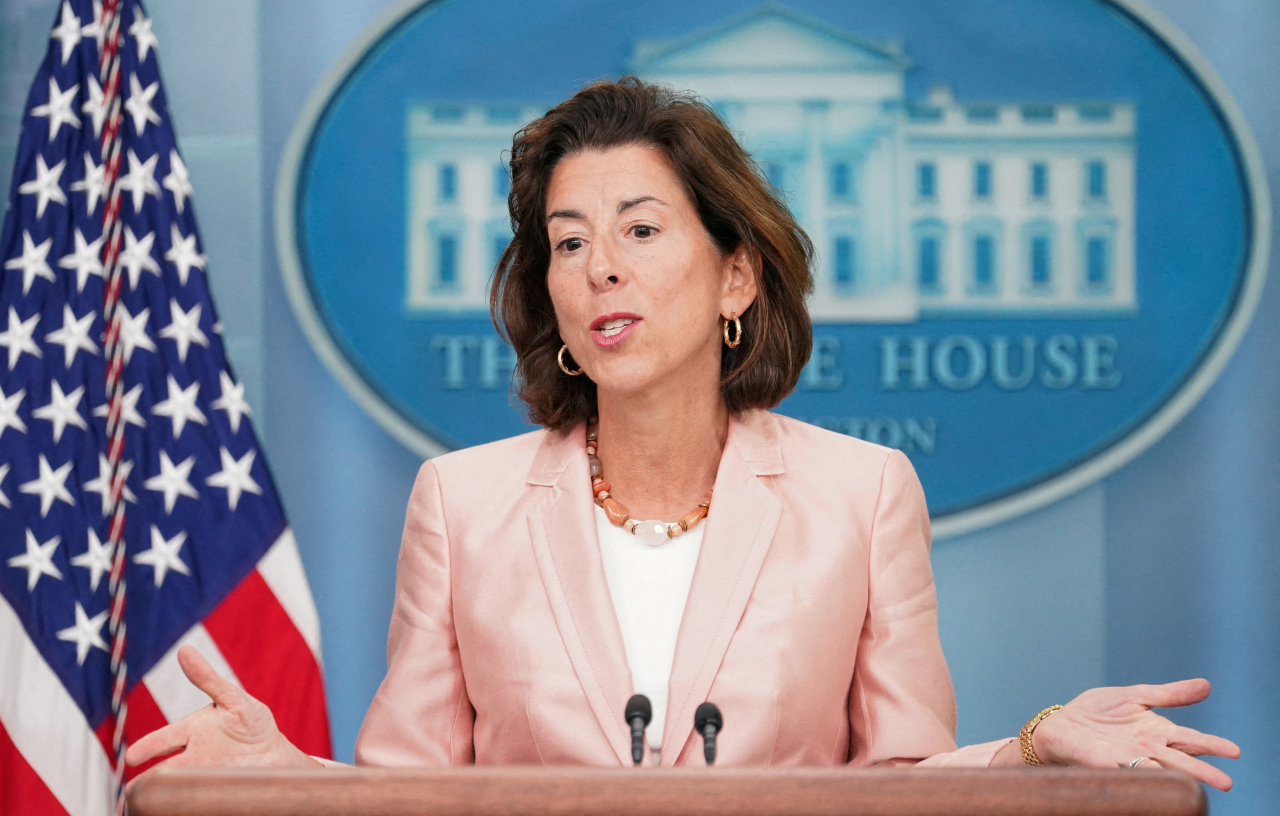 |
US Secretary of Commerce Gina Raimondo speaks about semiconductor chip subsidies during a press briefing at the White House in Washington, Sept. 6, 2022. (Reuters-Yonhap) |
The United States has revealed the details of its “guardrail” proposal for global chipmakers who wish to receive its chips subsidy and have production facilities in China, "loosening" the restriction by allowing the limited expansion of production capacity in China.
Home to two of the world's largest memory chipmakers, Samsung Electronics and SK hynix, Korea's chip industry is somewhat relieved that the guardrail statute “slightly opens up the windpipe” for Korean chipmakers. But it says more room is needed and calls the government to engage in further negotiations with the US.
On Tuesday, the US Commerce Department unveiled its proposal for the guardrails for its CHIPS for America Incentive Program, in which it moved to restrict the recipients of the incentives from increasing their facility production capacity in China and other “foreign countries of concern” by up to 5 percent. The other countries in which it hopes to restrict increases in production capacity are Russia, Iran and North Korea.
For facilities in China producing legacy chips, adding new production lines or expanding a facility's production capacity is allowed up to 10 percent. Legacy chips, as the US defines them, are logic chips produced with 28-nanometer technology or larger, with less than 128-layer NAND flash and over 18nm DRAM -- the older, and less critical chips.
The guardrails come as part of the requirements the US government has proposed for its $52 billion semiconductor funding program to attract global chipmakers to build chip production facilities within its borders. It is also largely aimed at countering China’s clout and gaining an upper hand against the strategic rival.
“CHIPS for America is fundamentally a national security initiative and these guardrails will help ensure malign actors do not have access to the cutting-edge technology that can be used against America and our allies,” US Secretary of Commerce Gina Raimondo said on Tuesday, declaring semiconductors as critical to US security.
When first revealed, the guardrail broadly stated it prohibits “significant transactions” involving material expansion of semiconductor manufacturing capacity for leading and advanced facilities in the countries of concern for 10 years.
The guardrail also had said it bans the recipients from constructing new or expanding existing advanced technology facilities in those countries.
Though Samsung and SK hynix have not yet revealed whether they would apply for the US incentives for their production facilities either currently under construction or planned for construction in the US, the regulation and requirements raised concerns, as they have invested some trillions of won (equivalent to billions of dollars) to build and operate chip plants in China.
“Before some would even worry that Samsung and SK may have to withdraw its production in the Chinese market, but (the latest regulation) shows that the chipmakers dodged the worst case scenario,” an industrial official said under the condition of anonymity.
Since 2012, Samsung has invested some 33 trillion won ($25.24 billion) to set up and operate chip plants in the Chinese city of Xian, which produce 40 percent of its total NAND flash chips. Its rival, SK hynix, also has invested some 25 trillion won and its Wuxi plant in China is responsible for producing almost half the chipmaker’s DRAM production.
“The latest announcement could be seen as slightly opening the windpipe for Korean chipmakers. But ultimately it would not be easy for Korean companies to continue investing in and upgrading facilities for advanced chips production in China, with the US in watch,” Kim Joung-ho, professor of semiconductor system engineering at the Korea Advanced Institute of Science and Technology, told The Korea Herald.
“The government should negotiate to raise the (facility) expansion percentage. Also, as the policy is renewed every year, it would make it difficult for companies to make long term plans, so the government should also request the US to prolong the duration to three years or 10 years.”
At the same time, the US CHIPS and Science Act still requires that subsidy applicants share sensitive business information and excess profits with the US government. Further negotiation would be needed, experts say.
As the US Commerce Department is accepting public comments on its guardrail notice for the next 60 days, the Korean Ministry of Trade, Industry and Energy said Wednesday it will keep up negotiations with the US to minimize uncertainties and losses for Korean chipmakers.







![[Today’s K-pop] Blackpink’s Jennie, Lisa invited to Coachella as solo acts](http://res.heraldm.com/phpwas/restmb_idxmake.php?idx=644&simg=/content/image/2024/11/21/20241121050099_0.jpg)